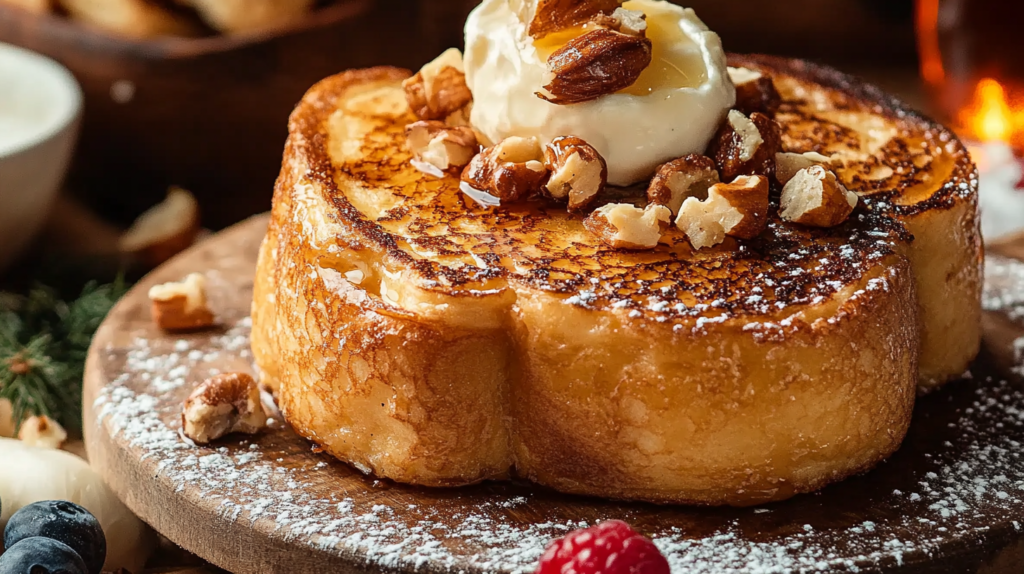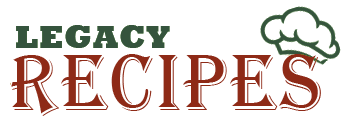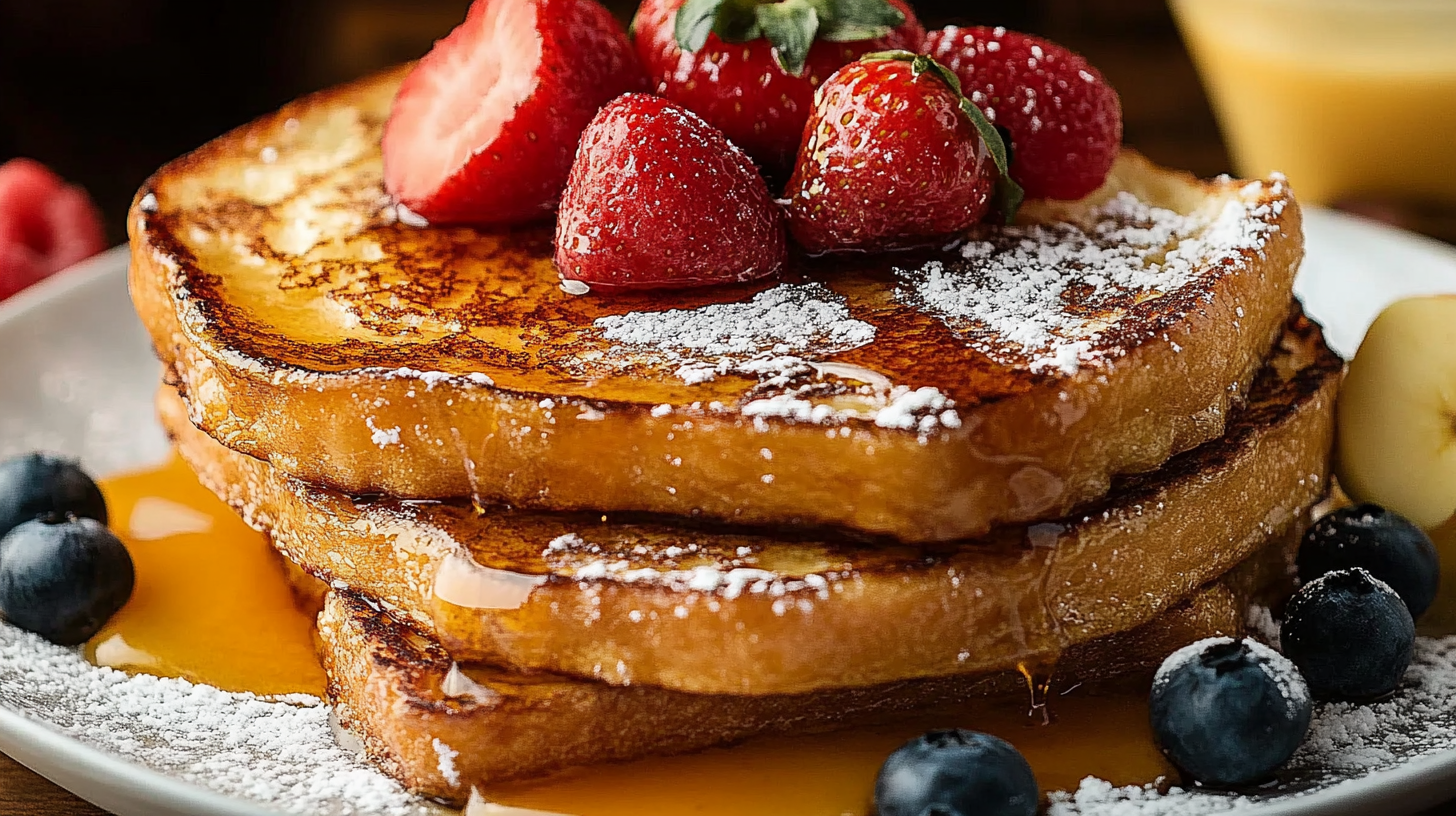French toast is a breakfast or dessert classic that’s beloved for its crispy edges, soft center, and deliciously versatile flavor. Made by soaking slices of bread in a creamy custard mixture of eggs, milk, and spices, French toast can be adapted to any taste, from simple to decadent. In this article, we’ll explore the origins of this beloved dish, various ways to make and customize it, tips for perfecting your technique, and the best toppings to make each slice a treat. Whether you’re a fan of traditional French toast or enjoy trying new spins, there’s a style here for everyone!
What Is French Toast?
A Simple Yet Luxurious Breakfast Dish
French toast is essentially slices of bread that are soaked in a custard-like mixture of beaten eggs, milk, sugar, and spices, then pan-fried to perfection. The result is a golden-brown exterior with a warm, creamy inside, often enjoyed with toppings like maple syrup, powdered sugar, or fresh fruit. Its simplicity is part of the charm, making it both easy to prepare and endlessly customizable.
Why French Toast Is So Popular
French toast is popular not only because it’s delicious but also because it’s versatile. You can use different types of bread, adjust the sweetness, add a variety of flavors, and pair it with countless toppings. French toast has a way of taking day-old or slightly stale bread and transforming it into something indulgent and comforting. Plus, it’s a perfect dish to enjoy as part of a cozy weekend brunch or a special morning treat.
A Brief History of French Toast
Ancient Beginnings and European Origins
French toast dates back centuries, with its origins rooted in ancient Rome, where they made a similar dish called pan dulcis. In medieval Europe, people would dip stale bread in a mixture of milk and eggs to create a filling, budget-friendly meal. This simple dish became known as pain perdu, which means “lost bread” in French, a name that still fits since the dish was a way to revive leftover bread.
French Toast in America
French toast made its way to America through European settlers, where it gradually became a breakfast favorite. Over time, the recipe adapted to regional flavors and ingredients, with Americans adding toppings like syrup and butter. The traditional French toast has since evolved into many regional variations, each with unique flavors and presentation.
Types of French Toast
Classic French Toast
Classic French toast is what most people think of when they hear the term. Made by dipping bread in a simple mixture of eggs, milk, sugar, and a dash of vanilla extract or cinnamon, classic French toast is a straightforward recipe that lets the bread’s flavor shine. It’s often topped with maple syrup and a sprinkle of powdered sugar, making it both sweet and satisfying.
Stuffed French Toast
For a more indulgent take, stuffed French toast adds a layer of filling between two slices of bread. Popular fillings include cream cheese, fruit jam, or Nutella. The bread is then dipped in the egg mixture and cooked until golden brown. Stuffed French toast is a crowd-pleaser, perfect for brunches or special occasions when you want to wow your guests.
Baked French Toast Casserole
A baked French toast casserole is ideal for feeding a crowd and can even be prepared the night before. This version involves arranging slices of bread in a baking dish, pouring a custard mixture over the top, and baking it in the oven. The result is a dish that’s soft on the inside with a crisp, caramelized top layer. It’s perfect for holidays or family gatherings when you want something comforting and hands-off.
How to Make French Toast from Scratch
Essential Ingredients
To make perfect French toast, you only need a few simple ingredients, but each one plays a key role in the final taste and texture:
- Bread: Thick slices of day-old bread work best as they soak up the custard mixture without getting soggy. Brioche, challah, and sourdough are popular choices.
- Eggs: The eggs add richness and create the custard that coats each slice of bread.
- Milk or Cream: Adding milk or even half-and-half makes the custard creamy and prevents the French toast from being too eggy.
- Sugar and Vanilla Extract: A touch of sugar sweetens the toast, while vanilla extract adds warmth and aroma.
- Cinnamon and Nutmeg (Optional): These spices add a touch of warmth, giving your French toast that classic, cozy flavor.
Step-by-Step Instructions
- Prepare the Custard: In a large mixing bowl, whisk together the eggs, milk, sugar, vanilla extract, and spices until smooth and well combined.
- Soak the Bread: Heat a skillet or griddle over medium heat and melt a small amount of butter. Dip each slice of bread into the custard mixture, allowing it to soak for a few seconds on each side, but not too long or it may become mushy.
- Cook the French Toast: Place the soaked bread on the skillet or griddle and cook for about 2-3 minutes on each side, until each slice is golden brown and slightly crisp on the edges.
- Serve and Enjoy: Serve immediately with your choice of toppings, from classic maple syrup to fresh berries, whipped cream, or a dusting of powdered sugar.
For more tips on making perfect French toast, check out Food Network’s classic recipe guide.
Tips for Perfecting French Toast
Use Stale Bread
One of the secrets to achieving perfect French toast is using slightly stale bread. Fresh bread often becomes too soft and falls apart, but day-old bread holds up better when soaked in the custard mixture. Brioche and challah are especially great because of their thick, absorbent texture.
Optimize Soaking Time
How long you soak the bread can make a big difference. If you’re using a thicker bread, allow it to soak for several seconds to absorb enough custard. For thinner bread, a quick dip should suffice to prevent it from becoming too soggy.
Cook at the Right Temperature
French toast should be cooked on medium heat to ensure it gets golden and crispy without burning. High heat may cause the outside to cook too quickly, leaving the inside undercooked, while low heat won’t create that desired crispy texture.
For more expert tips, you might enjoy reading Natasha’s Kitchen’s French toast tips.
Serving Suggestions and Toppings

Classic Maple Syrup and Butter
There’s something timeless about topping French toast with warm maple syrup and a pat of butter. The syrup’s sweetness pairs perfectly with the toast’s soft center, making this a simple yet delightful choice.
Fresh Fruits and Berries
Adding fresh fruits, such as strawberries, blueberries, or bananas, brings natural sweetness and a pop of color to your French toast. Fruits also add a layer of texture, making each bite more interesting.
Whipped Cream and Powdered Sugar
For a more indulgent take, add a dollop of whipped cream and a sprinkle of powdered sugar. These toppings transform French toast into a dessert-like experience, perfect for brunch or special occasions.
Nut Butters and Spreads
Almond butter, peanut butter, or Nutella can be spread on top for a rich and slightly savory twist. These spreads add extra flavor and are great for creating a heartier breakfast that’s satisfying and full of flavor.
Frequently Asked Questions About French Toast
Can I Freeze French Toast?
Yes, French toast freezes well and makes a convenient make-ahead breakfast. After cooking, allow the slices to cool completely, then layer them with parchment paper in between to prevent sticking. Place the slices in an airtight container or freezer bag, and they’ll keep for up to two months. To reheat, pop them in a toaster or warm them in a 375°F oven for 8-10 minutes. This way, you can enjoy French toast any day of the week without the fuss!
How Long Does French Toast Batter Last?
The custard mixture, or French toast batter, can be stored in the refrigerator for up to 24-48 hours. However, for the best flavor and texture, it’s ideal to use it within the first day. If you plan to make French toast the following day, give the batter a quick whisk before using.
Can I Make French Toast Without Eggs?
Yes, there are easy ways to make egg-free French toast for those with dietary restrictions or preferences. Common substitutes include mashed bananas, applesauce, or a “flax egg” (1 tablespoon ground flaxseed mixed with 3 tablespoons water). These substitutes help create the creamy texture of traditional French toast without eggs.
What Is the Difference Between French Toast and Bread Pudding?
While both dishes involve soaking bread in a custard mixture, there are some key differences. French toast is typically pan-fried, resulting in a crispy exterior, while bread pudding is baked, giving it a soft, pudding-like texture throughout. Bread pudding often includes additional ingredients like raisins or nuts and is usually served as a dessert, whereas French toast is a popular breakfast dish.
Why Is My French Toast Soggy?
Soggy French toast can be a common issue, often caused by using fresh bread or soaking the bread too long. To avoid sogginess, opt for day-old bread with a firmer texture, and give it a quick dip in the custard mixture instead of letting it sit too long. Additionally, cooking on medium heat helps the bread firm up without burning.
Conclusion
French toast brings comfort and versatility to the breakfast table, allowing for endless ways to customize each slice. Whether you stick to a classic recipe or get creative with stuffed French toast or a baked French toast casserole, this dish is sure to delight. With tips on achieving the perfect texture and a variety of serving suggestions, you’re all set to make French toast that’s crispy on the outside, soft on the inside, and just the right amount of sweet. Gather your favorite toppings, heat up the skillet, and enjoy this timeless breakfast treat.

